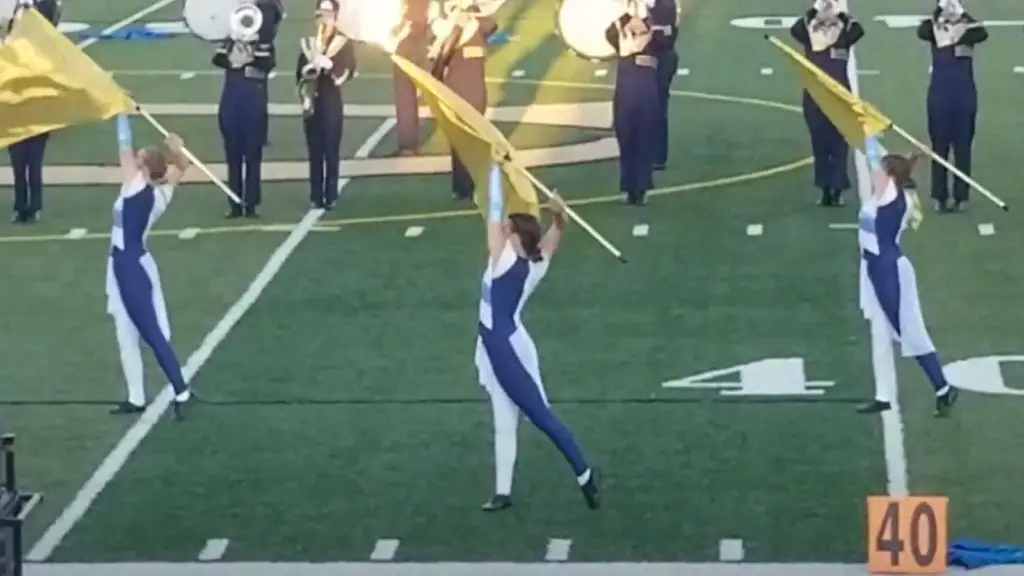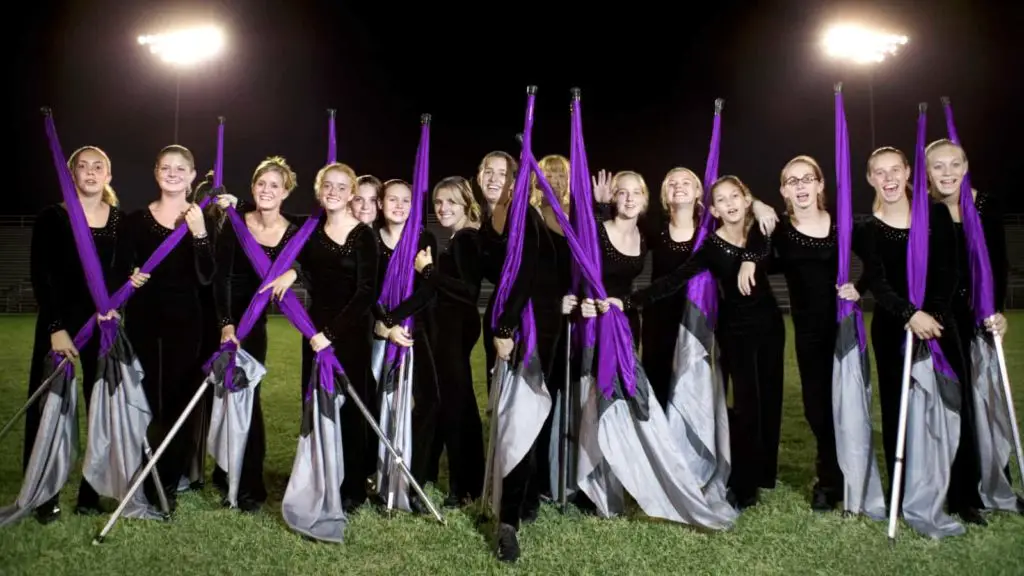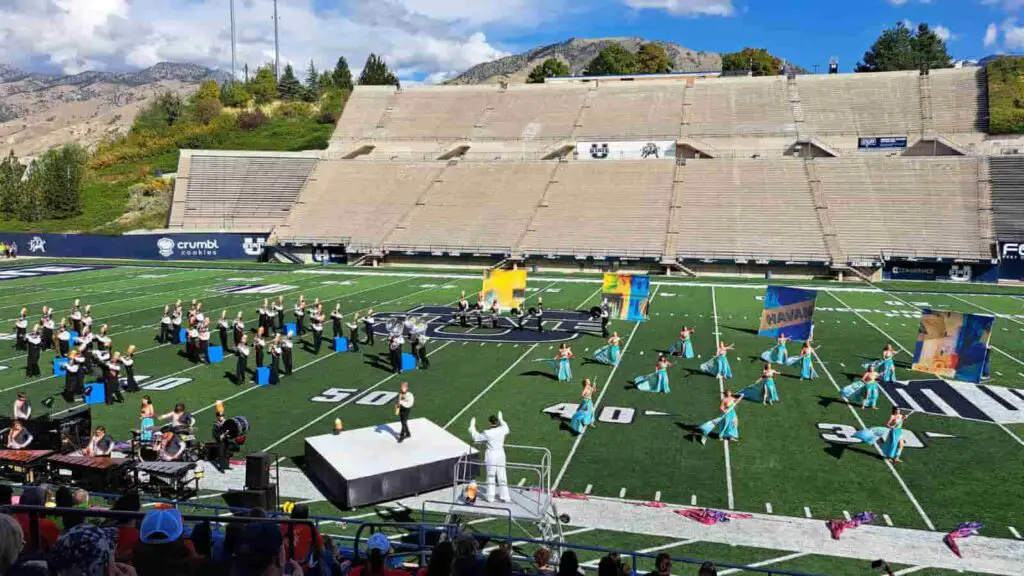My daughter was talking with a friend the other day about being in color guard her friend (we’ll call him Max) was poking fun at her for calling Color Guard a sport. Rightfully so my daughter defended herself. She let Max know about the amount of physical exertion and practice required of her to be in color guard. After sharing this conversation with me I thought we should put the subject to rest once and for all!
Color Guard is not officially recognized as a sport, but because of its strenuous physical demands and its competitive nature, it fits the definition of a sport. Color Guard is an activity that involves skill as well as physical exertion performed with a team that competes against others for entertainment.

Unfortunately, because Color Guard is not as popular as other sports it may be hard for some people like Max to believe that is actually considered a sport. Here is my argument to see if I can change his mind.
What Defines a Sport
Dictionary.com defines a sport as “an athletic activity requiring skill or physical prowess and often of a competitive nature” then it mentions racing, baseball, bowling, and a few others.
Wikipedia says “Sport pertains to any form of competitive physical activity or game that aims to use, maintain or improve physical ability and skills while providing enjoyment to participants and, in some cases, entertainment to spectators.”
✔ Does Color Guard require skill? …… Yes!
✔ Does Color Guard require and improve physical ability? … Yes!
✔ Does Color Guard require athleticism? ….. Yes!
✔ Is Color Guard competitive? ….. Yes!
✔ Does Color Guard provide entertainment or enjoyment to an audience? ….. Yes!
✔ Can you get injured in Color Guard? …. Yes!
Color Guard fits every aspect of the definition of a sport!
Is Color Guard a sport? ✔ YES!
Does Color Guard Require Skill
Color Guard requires a lot of different skills. These skills include teamwork, endurance, proper technique, marching, musical timing & rhythm, synchronization, flexibility, and technical knowledge of how to execute different flag tosses and holds.
Colorguard Requires Teamwork
Working together for a common purpose as a team is a hallmark of any sport. There can be anywhere from 1 to 50 people (flaggers) on a Color Guard team, but even if there is only 1 person they still work in tandem with the marching band.
The team members need to be aware of their team members’ strengths and weaknesses so that they can help each other improve, they also need to work together to make their movements synchronized together.

Color Guard Requires Endurance
Even though the typical halftime show that a Color Guard performs in is only 5-15 minutes long practices often last an hour or more.
During band camp, Color Guard will sometimes practice all day. The flags can be heavy and require a lot of arm and wrist strength to perform and practice the tosses over and over again.
Over the summer my daughter attends band camp as a member of the Color Guard with her high school.
The first week runs from 8 am to 5 pm with a short lunch break in the middle of the day. The next week goes from 8 am to 9 pm every day practicing drills with the Marching Band as well as practicing on their own with just the Color Guard.
During band camp, while the Marching Band is inside sitting and rehearsing the Color Guard is often still on their feet practicing movements and tosses.
Color guard is a very physically demanding sport!
Color Guard Requires Knowledge and Technique
Just like a lot of sports have a playbook color guard has something similar that needs to be studied and understood, and that is a drill chart. Knowing the technical terms and understanding how to implement it together with the team is a huge part of this sport.
Being in Color Guard also requires you to learn the basic flag moves and techniques. You need to know how to toss different types of tools, mainly a flag, a rifle, and a sabre.
Color Guard Sabres (Your Complete Guide)
All About Color Guard Flags (Complete Guide)
Color Guard Requires Flexibility, Timing, and Rythm
Just as Gymnastics requires flexibility, Basketball and Football are about good timing, and believe it or not Baseball requires some degree of rhythm Color Guard uses ALL of these things!
Because of the dance moves involved in Color Guard flexibility of the body is important. Timing the tosses of the flags together with your team is important to score well in competitions, and an overall rhythm and flow help Color Guard to sync up with the other members of their team as well as the Marching Band as a whole.

Color Guard Requires Physical Ability and Athleticism
A member of the color guard is often the most mobile and quickly moving person on the Marching Band field. Not only do they march in step with the band, but they run, leap, jump, and dance. Their contribution to the band is their movement.
In one of my daughter’s drills for her halftime show this year she is required to leap in several short counts (Jazz Run) from one position in the field to nearly the other side of the field. If you are not physically fit these short bursts of high-intensity movements along with maintaining the physical demands of the rest of the show can be very challenging.
Color Guard is Competitive
At a high school level, Color Guards and Marching Band in the fall will compete against regional bands usually on the weekends. This often involves traveling to different schools and performing at an assigned timeslot in front of an audience and judges.
The judges will critique the players on a range of skills including musicality, technical execution, and synchronization. The band then gets a score and feedback on how to improve their show.
Color Guard members can also compete during the off-season of Marching Band in the Winter Guard. There is an
WGI or Winter Guard International has been running indoor Color Guard competitions since the 1970s.
Color Guard Provides Entertainment and Enjoyment to an Audience
Many football fans can attest that sometimes the most exciting part of the football game is the halftime show. I remember being in the Marching band at Utah State University and feeling hyped and extremely nervous to perform in front of a huge homecoming audience.
We did some pretty fantastic shows. One was a tribute to the Beatles, and one was all about Scooby doo. The shows were meticulously choreographed and definitely entertaining.
Getting the crowd going with cheers and yelling was one of my favorite things about performing!
Throwing the flag and twirling it every which way can be considered a ‘sport of the arts’ it is so graceful as it tells a story while bringing music to life and evoking a lot of emotion.
At my daughter’s high school they will often invite spectators to come and watch the competitions. They may even charge a small sum of money as an entrance fee. The money goes towards paying for the costs of Marching Band.
Is it not typical that a sport is meant to perform and entertain an audience in exchange for a fee to watch the game?

Can You Get Injured in Color Guard?
Yes, getting injured in Color Guard is a real possibility. Musculoskeletal injuries are the most common. Because the flag is heavy and takes skill to toss and catch, learning and practicing can cause bruises, broken noses, strained muscles, or other injuries while practicing. Ankle sprains are also common injuries from marching.
As with any sport you have to take a calculated risk as well as precautions to try and minimize that risk. Color Guard members often wear gloves as well as have very sturdy athletic shoes to help support and avoid injury.
I remember towards the beginning of my daughter’s first year in Color Guard she came home one day with a black and purple knee with a big gash in the center. Apparently, she had hit it just right with the end of her flag that it caused quite a bit of injury and pain. Luckily it was just superficial and not anything too serious.
Top Tip: Want to know what else is hard about color guard? Check out our article 10 Reasons Color Guard is Hard (Is it Worth it?)
Is Color Guard or Winter Guard an Olympic Sport?
Of the 46 different Olympic sports Color Guard is not one, however, there are many people who would like to make it an Olympic sport. You can find many petitions online to sign that are trying to prove that Color Guard is a sport and should be included in the Olympics.
Artistic Gymnastics is most likely the closest related sport that is currently in the Olympics.
Why is Color Guard Not Considered a Sport?
Color Guard is not considered a sport because of the naivety of people to understand the amount of physical exertion and work involved in learning and executing routines. It can also be because it lacks in popularity behind cheerleading and other dance-like sports that get more attention.
Color Guard only needs to get its chance to be in the spotlight so people can realize how exciting, powerful, and difficult a sport it is. Once this happens then I believe everyone will unanimously agree that Color Guard is a sport!!
Up Next: All About Color Guard Flags (Complete Guide)
Disclaimer: This post may contain affiliate links. We only recommend high-quality products that are used and recommended by real musicians. If you use these links to buy something we earn a small commission.
